Progonoplexia is defined as having a deep obsession with one’s ancestry. And given the number of new companies (23AndMe.com, Ancestry.com, FamilyTreeDNA.com, MyHeritage.com, etc.) that cater to tracing lineages and analyzing ancestry, I’m sure that most people are suffering from progonoplexia as well.
I’ve always been interested in tracing my lineage and can recall at a young age asking both of my parents about our family history. Several interesting stories about Grandparents and Great Grandparents (e.g. Great Grandfather had one of the few legal licenses to sell opium in Tainan, Taiwan) surfaced but really no knowledge or details beyond the Great Grandfather generation.
We got a big break in 1999 when my parents, Eugenia and I visited Taiwan together. While visiting my father’s hometown of Tainan, we visited a cousin of my father’s, who still runs the old family business — the oldest tea shop in Tainan. I asked my father to ask him if he knew additional ancestry details such as, “How many generations has the family been living in Taiwan?” or “Where from Mainland China did our ancestors come from?”
I watched as my father’s cousin walked over to an old wooden cabinet and took out a large tin box. Inside the dented tin box was this…

A 20-page, hand-recorded booklet of the Yen Ancestry that documented 8 generations in Taiwan and detailed out the village in QuanZhou in the FuJian province of China where my original ancestors emigrated. Wow!
Which brings me to present day. I recently took the 23AndMe ancestry test and guess what, I’m 95.2% Chinese! Not sure if that percentage surprises me or not. If the percent showed 100%, that would make sense. But if the percent showed 80-90%, that would not surprise me either as over the years, the intermingling of the “powers” of Taiwan including the Portuguese, the Dutch, and the Japanese along with the native Taiwan Aborigines would certainly make sense. Here is the summary of the report:

And now some more interesting points to note based on the chart below:
- I most likely had a third great-grandparent, fourth great-grandparent, fifth great-grandparent, or sixth great-grandparent who was 100% Southeast Asian. This person was likely born between 1730 and 1820. Southeast Asian = the land from Burma to Indonesia.
- I most likely had a third great-grandparent, fourth great-grandparent, fifth great-grandparent, sixth great-grandparent, or seventh great (or greater) grandparent who was 100% Korean. This person was likely born between 1700 and 1820.
- I most likely had a fourth great-grandparent, fifth great-grandparent, sixth great-grandparent, or seventh great (or greater) grandparent who was 100% South Asian. This person was likely born between 1700 and 1790. South Asian = India, Pakistan, Afghanistan, and Bangladesh

So very interesting as we have some “mixed” blood so to speak. After reading through many forums, I came across a website that focuses on Asian ancestry and can provide a more detailed mapping. The website is called Wegene.com and I ran my DNA through that website with the following results:

Wegene.com came up with a 99.96% Chinese ancestry with a 2.67% Dai Ethnic Minority. While the percentages may be different, this seems to be consistent with the 23andMe.com analysis of having a relative who was 100% Southeast Asian.
More interesting is the 8.92% GaoShan ancestry. “GaoShan” is loosely translated as “High Mountain” and refers to the Taiwanese Aborigines who mainly lived in the mountainous areas and the eastern coast of Taiwan. Within the GaoShan, there are 16 major groups or “tribes” of which WeGene.com associated my DNA with the Amis and Atayal ethnic groups.
Okay, I know that I may be the only one who is finding this information fascinating given that it’s all about me, but here’s the last finding I’ll talk about. Haplogroups leverage the Y-DNA that is passed solely along the patrilineal line, from father to son, and the mtDNA which is passed down the matrilineal line, from mother to offspring of both sexes.

With this information, you can track the basic migration of my ancestors. On the paternal side, migrating into China and Taiwan from the Southeast Asia route. On the maternal side, migrating into China and Taiwan from the Northeast Asia route.
Fascinating stuff and I’m continuing my research on my ancestry. Hope you do the same and one day, the world will have a cure for Progonoplexia!

March 7, 2017 at 9:00 pm
I continue to be surprised and amazed by your writing skills. Maybe blogging is your future. Too bad you weren’t into Progonoplexia when I had worked for Geni.
LikeLike
March 8, 2017 at 4:03 am
Thanks AT. You were way ahead of your time when you worked at Geni.
LikeLike
March 22, 2017 at 6:08 am
Alan is probably the most supportive friend ever! Thanks for your sleuthing, Ben! Really interesting info! I knew you had Hakka roots. Now let’s do something about your leaky gut… xoxo
LikeLike